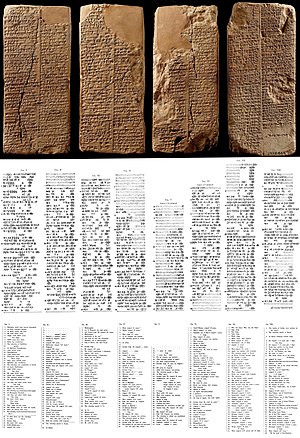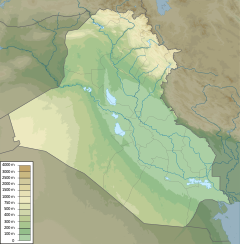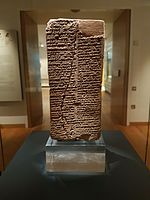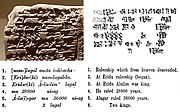| Weld-Blundell Prism | |
|---|---|
 Weld-Blundell Prism, with transcription and translation by Stephen Herbert Langdon (1876–1937). Weld-Blundell Prism, with transcription and translation by Stephen Herbert Langdon (1876–1937). | |
| Material | Clay |
| Size | 20x9 cm |
| Created | 1800 BCE or 1817-1800 BCE |
| Discovered | Probably Larsa 31°17′09″N 45°51′13″E / 31.285833°N 45.853611°E / 31.285833; 45.853611 |
| Present location | Ashmolean Museum, Oxford |
| Registration | AN1923.444. |
  | |
The Weld-Blundell Prism ("WB", dated 1800 BCE) is a clay, cuneiform inscribed vertical prism housed in the Ashmolean Museum in Oxford. The prism was found in a 1922 expedition in Larsa in modern-day Iraq by British archaeologist Herbert Weld Blundell. The four sides, about 20 cm high and 9 cm wide, are inscribed in the Sumerian language with lists of Sumerian kings; each side contains the text in two columns: this is the famous Sumerian King List. It is considered as the most complete of the Sumerian King Lists which have been found, of which there are approximately 25 more or less complete fragments as of 2016.
The list begins with the antediluvian rulers and ends with Sin-magir of the Isin dynasty (r. 1827–1817). The list was most likely written in Sin-magir's final year, or soon after. Many, especially antediluvian, kings are credited with incredibly long reigns (counted in sars and nerah), as a result of which many scholars consider this work to be more artistic than historical.
Various theories are being constructed in an attempt to explain such large numbers. They are supposed to express the great importance of rulers who were considered demigods. According to another version, sar (3600 years) and ner (600 years), the units of time measurement in the Sumerian number system, should be taken as years and months, respectively.
This text of the Old Babylonian period (Isin dynasty, c. 1827 – c. 1817 BCE) is inscribed in traditional Sumerian cuneiform.
-
 The Weld-Blundell Prism in the Ashmolean Museum.
The Weld-Blundell Prism in the Ashmolean Museum.
-
 Weld-Blundell Prism, initial paragraph about rule of Alulim and Alalngar in Eridu for 64.800 years
Weld-Blundell Prism, initial paragraph about rule of Alulim and Alalngar in Eridu for 64.800 years
See also
References
- Langdon, S. (1923). The Weld-Blundell Collection, vol. II. Historical Inscriptions, Containing Principally the Chronological Prism, W-B. 444 (PDF). Oxford Editions of Cuneiform Texts. pp. 8–21. Archived from the original (PDF) on 2015-10-31.
- ^ Milstein, Sara Jessica (2016). Tracking the Master Scribe: Revision Through Introduction in Biblical and Mesopotamian Literature. Oxford University Press. p. 45. ISBN 978-0-19-020539-3.
- ^ "Weld-Blundell Prism". University of Oxford - Ashmolean Museum.
- Van De Mieroop, Marc (2016). A History of the Ancient Near East (3rd ed.). Oxford: Wiley Blackwell. p. 47.
- "Kingdoms of Mesopotamia - Sumer". The History Files.
- Chrisomalis, Stephen (15 December 2020). Reckonings: Numerals, Cognition, and History. MIT Press. p. 36. ISBN 978-0-262-04463-9.
External links
- Information on the Ashmolean Museum's website
- "The Sumerian king list: translation". etcsl.orinst.ox.ac.uk. Archived from the original on 2008-05-08.
- Langdon, Stephen Herbert (1923). Oxford editions of cuneiform texts - The Weld-Blundell Collection, vol. II. Historical Inscriptions, Containing Principally the Chronological Prism, W-B. 444 (PDF). Oxford University Press. pp. 1–27, Plates I-IV.
- "CDLI-Archival View". cdli.ucla.edu.